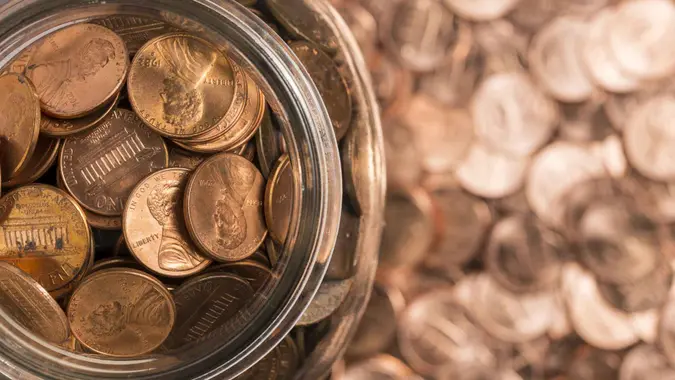6 Ways To Create a Financial Safety Net With Your Bank, According to Experts

Commitment to Our Readers
GOBankingRates' editorial team is committed to bringing you unbiased reviews and information. We use data-driven methodologies to evaluate financial products and services - our reviews and ratings are not influenced by advertisers. You can read more about our editorial guidelines and our products and services review methodology.

20 Years
Helping You Live Richer

Reviewed
by Experts

Trusted by
Millions of Readers
Creating a financial safety net is crucial when planning for your financial future and establishing a reliable financial cushion can provide peace of mind and stability. A financial safety net can act as a buffer in case of sudden job loss, illness or any other unforeseen circumstances that may impact your income.
Having this money on hand can help you avoid going into debt or dipping into your long-term investments during times of crisis.
Here are six ways to get started with your safety net and reach your savings goal according to financial experts.
1. Set Aside Planned Savings
The first step in establishing a financial safety net is to set aside planned savings. Determine a specific percentage of your income to save each month and automate the process.
Setting up automatic transfers and direct deposit ensures that you’re consistently saving, while at the same time reducing financial risk,” says Kristy Kim, Founder at TomoCredit. “This is a key strategy for creating your financial safety net with the bank you work with.”
2. Cut an Expense and Redirect The Money You Saved
Another effective way to build your safety net is by cutting unnecessary expenses and redirecting the money you save into your savings account. Review your monthly spending and identify areas where you can reduce costs, such as dining out, subscription services or impulse purchases.
“Any time you reduce expenses in a small way, move the savings over to your savings account,” says Scott Lieberman, Founder of Touchdown Money. “This can be a good starting point to reward yourself when you hit a savings goal.”
Lieberman also encourages that you automate your savings transfers including the money you get from reducing expenses.
“If you’re saving $5-10 a week automatically, you won’t miss it in your paycheck, but you will notice it in your savings,” he adds.
3. Build an Emergency Fund with a High Yield Savings Account
An emergency fund is a crucial part of your financial safety net to help you cover emergency expenses. This fund should cover at least three to six months’ worth of living expenses and be easily accessible in case of unexpected events like job loss, medical emergencies, or urgent repairs.
Michael Micheletti, a consumer finance expert and Chief Communications Officer at financial technology company Unlock, recommends using a high-yield savings account to build your emergency fund so your money can grow faster with a higher interest rate.
“A bank is an excellent place to have those readily available funds since most banks guarantee deposits up to $250,000,” Micheletti says. “So in a worst-case scenario, you would not lose your money and now, many banks are offering great rates on savings accounts — many over 4%.” Be sure to do online research to identify where the best rates are offered; it may or may not be your current bank.”
Micheletti also warns that people should keep in mind that some savings accounts have minimum deposit requirements, and getting the highest rate may require a higher opening deposit but this is not always the case.
4. Start a Side Gig Solely For Building Your Safety Net
Starting a side gig can provide additional income that you can dedicate to building your financial safety net. Whether it’s freelancing, tutoring or selling handmade goods, a side gig can help accelerate your savings goals. Identify a skill or hobby that you can monetize. Then, research the market demand and potential earnings for your side gig.
“If your goal is to build a strong safety net, you should put all the profits from your side hustle directly toward savings so you can grow your balance quicker,” Lieberman says.
It may also help to set up a separate bank account to manage your side gig income.
5. Make Sure You Turn on Account Alerts
Creating a financial safety net can be hard work so it’s best to make sure your funds are protected by setting up account alerts with your bank.
“With the rise of cyber and financial fraud, it’s critical to set up bank account alerts for spending, receiving funds, credit score checks and even upcoming bills,” says Kim. “Bank alerts are an easy way to help you stay on top of your banking management and prevent unnecessary issues — and something in this day and age that everyone should be doing.”
6. Incorporate a Budgeting Tool
Using a budgeting app or budgeting software can help you track your expenses, set savings goals and manage your money effectively. While banks may offer helpful budgeting tools and resources, you may want to use a budgeting app to stay organized so you can connect all your financial accounts in one place.
“Budgeting apps can track a variety of financial accounts across a number of institutions, including bank accounts, investments, credit cards, loans, and more,” says Kristen Dillard, VP of Product Management at Quicken. “By using a dedicated budgeting app, consumers gain real-time insight into spending habits and can easily see the progress they’ve made towards short and long-term savings goals.”
Dillard adds that by using bank-created solutions alongside dedicated budgeting apps, people can effectively manage their finances, meet goals, and build wealth.
More From GOBankingRates
 Written by
Written by  Edited by
Edited by 

























